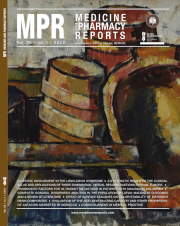Fistulectomy and incontinence: do we really need to worry?
DOI:
https://doi.org/10.15386/mpr-2045Keywords:
fistula in ano, fistulectomy, incontinence, recurrenceAbstract
Background. Anal fistula is often considered to be a dilemma because of the need to maintain a fine balance between postoperative incontinence and recurrence. We tried to find whether apprehension of causing incontinence should stop us from performing fistulectomy. The aim of this study was to determine whether fistulectomy was associated with increased rate of fecal incontinence and recurrence, compared to other procedures used for the treatment of anal fistula.
Methods. It was a prospective, single center, observational study. All patients with anal fistula operated at a tertiary care teaching institute over a period of two years were included in the study. Recurrence rates and fecal incontinence were compared between patients subjected to fistulectomy and other procedures for treatment of fistula in ano.
Results. A total of 124 patients with anal fistula were included. 92.8% patients were ≤ 60 years of age with high male preponderance (89.5%). Perineal discharge was the commonest complaint (95.96%). Intersphincteric (47.58%) followed by transphincteric fistulas (45.16%) accounted for the majority of fistulas. Fistulectomy was the most common procedure, performed in 90 (72.58%) patients. Incontinence occurred in 8/90 (8.88%) from the fistulectomy group and 2/34 (5.9%) patients in other surgery group, p=0.726. Recurrence occurred in 8/90 (8.88%) from the fistulectomy group and 8/34 (23.5%) patients from other surgery group, p=0.038. Overall rates of incontinence and recurrence were 8.1% and 12.9% respectively.
Conclusion. Fistulectomy, as compared to other procedures, results in less chances of recurrence without compromising continence.
Downloads
Published
How to Cite
Issue
Section
License
The authors are required to transfer the copyright of the published paper to the journal. This is done by agreeing to sign the Copyright Assignment Form. Whenever the case, authors are also required to send permissions to reproduce material (such as illustrations) from the copyright holder.

The papers published in the journal are licensed under a Creative Commons Attribution-NonCommercial-NoDerivatives 4.0 International License.

